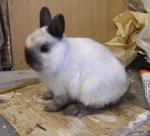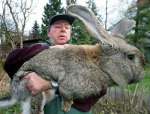Rabbits are fun to raise. You may have different reasons for raising them, enjoyment, education, business, show, table meat, fur, and their bi-products such as fertilizer and to raise fishing worms.
Rabbits are mostly non-aggressive, gentle and easy to manage. Older doe’s and bucks with age will become defensive of their territory ie. their cage or hutch area and may attempt to scare you off by thumping their feet on the bottom of the cage indicating that you are intruding on their space and territory.
Caution They seldom bite but under threat can and will bite you or more likely scratch you. They have long and sharp nails that can cause a serious wound.
Rabbits used as breeders are best replaced every 3 years for large breeds, 4 years for medium size breeds and about every 6 years or so for smaller breeds.
Large breed rabbits live about 5 years and small breeds may live 10 or more years.
 Rabbits as a pet. Small breeds live longer and may be a better choice as a pet. Keep in mind that rabbits Are Not a good choice for small children.
Rabbits as a pet. Small breeds live longer and may be a better choice as a pet. Keep in mind that rabbits Are Not a good choice for small children.
Rabbits are small, and easily injured from ruff or mishandling by small children.
Medium and large breeds are your best choice for table meat.
Rabbits can tolerate cold weather well if given shelter from rain, snow and ice storms.
However the same can’t be said for summer time heat. Rabbits become heat stressed and can die when air temperatures exceed 95 degrees. Bucks become temporarily sterile at about 92 degrees and doe’s stop breeding. Without lots of cold fresh water your entire rabbit flock can die within a few hours.
Temperature controlled housing with very good ventilation is your best bet. Overhead Fans is also a good choice to keep your rabbit cool. However when the air temperature reaches 95 degrees, a fan does not cool the air if only moves the hot air from one place to another.
If you are unwilling or unable to provide proper housing to keep you rabbit(s) cool in summer and protected from harsh winter weather, you should Not consider raising rabbit(s).
Selecting the breed rabbit you want to raise.
The smallest breeds, the Dwarfs, vary in size from 1-3/4 to 3-1/2 lbs.
Britannia Petite (White, black, black otter, or chestnut agouti) 1-1/2 – 2-1/2 lbs
Dwarf Hotot (White with black around its eyes) 2 – 3 lbs
Jersey Wooley (Many colors – Angora wool) 2 – 3-1/2 lbs
Netherland Dwarf (Many colors) 1-3/4 – 2-1/2 lbs
Polish (Black, blue, chocolate, blue eyed white, ruby eyed white, and broken) 2 – 3-1/2 lbs
These rabbits, as a group, are less than 3-1/2 pounds mature. These are the rabbits you will want to raise if you want small pets that don’t consume much feed (about 1/3 to 1/2 cup per day) and take up the least amount of cage/hutch space (about 2-1/2 sq ft).
Small Breeds
The next group of rabbits make up the small size breeds. They vary from about 2-1/2 to 5 pounds. These rabbits consume between 1/3 and 2/3 cup of feed per day and take up 3-1/2 sq ft of cage space.
American Fuzzy Lop (Many colors – Angora fur – Lop Ears) 3 – 4 lbs
Dutch (The feet, front half of torso and face are white, the other parts can be black, blue, chocolate, tortoise, steel, or brown-gray) 3-1/2 – 5-1/2 lbs
Himalayan (White with colored ears, nose, feet, and tail of black, blue, lilac, or chocolate) 2-1/2 – 4-1/2 lbs
Holland Lop (Lop ears – Many colors) 2-1/2 – 4 lbs
Mini Rex (Rex coat – Many colors) 3 – 4-1/2 lbs
Medium Size Breeds
The next group of rabbits make up the medium size breeds. This group is characterized by weights ranging from 4-1/2 to 7 pounds mature. These rabbits consume between 1/2 and 1 cup of feed per day and take up 5 sq ft of cage space.
American Sable (Also good for meat) 7-10 lbs
English Angora (Many colors) 5 – 7-1/2 lbs
French Angora (Many colors – good also for meat) 7-1/2 – 10-1/2 lbs
Satin Angora (Many colors) 6-1/2 – 9 lbs
Belgian Hare (Not seen much – different body style) 6 – 9-1/2 lbs
Standard Chinchilla 5 – 7-1/2 lbs
English Spot (White with spots of black, blue, chocolate, gold, gray, lilac, or tortoise) 5 – 8 lbs
Florida White 4 – 6 lbs
Harlequin (Has alternate bands of color) 6-1/2 – 9-1/2 lbs
Havana (Black, blue, or chocolate) 4-1/2 – 6-1/2 lbs
Lilac 5-1/2 – 8 lbs
Mini Lop (Lop ears – Many colors) 4-1/2 – 6-1/2 lbs
Rhinelander (White with spots of black and orange) 6-1/2 – 10 lbs
Silver (Black, brown, or fawn with white ticking) 4 – 7 lbs
Silver Marten (Black, blue, chocolate, or sable, white on belly, flanks, jaw lines, and eye circles) 6 – 9-1/2 lbs
Tan (Black, blue, chocolate, or lilac with tan on belly, flanks, jaw lines, and eye circles) 4 – 6 lbs
Meat Rabbits
Meat Rabbits make up the next group. They are characterized by weights between 8 and 12 pounds. These rabbits are raised for both meat and fur. Some of these may also be considered fancy rabbits because they have unusual fur, color, or ear characteristics. Most of these rabbits are shown a great deal. Rabbits in the meat group consume about 1-1/4 cup of feed per day and take up 7-1/2 sq ft of cage space.
American (Blue or White) 9 – 12 lbs
Beveren (Black, Blue, or White) 8 – 12 lbs
Californian (White with black ears, nose, feet, and tail) 8 – 10-1/2 lbs
Champagne D’Argent (Starts as black, mature is silver) 9 – 12 lbs
American Chinchilla 9 – 12 lbs
Cinnamon 8-1/2 – 11 lbs
Creme D’Argent 8 – 11 lbs
Hotot (White with black around its eyes) 8 – 11 lbs
English Lop (Many colors – giant lop ears) 9 – 14 lbs
French Lop (Many colors – regular lop ears) 10 – 15 lbs
New Zealand (Black, Red, or White) The standard meat rabbit 9 – 12 lbs
Palomino 8 – 11 lbs
Satin (Shiny coat – many colors) 8-1/2 – 11 lbs
Silver Fox (fur resembles fox) 9 – 12 lbs
 The Giants
The Giants
This group of rabbits are rabbit giants. These are raised because some breeders just like giant rabbits. They can sometimes weigh up to 25 pounds. The giants require 1-3/4 – 2 cups of feed per day and 11 – 12 sq ft of cage space. The giant breeds also require stronger cages. Because few people raise these rabbits, they are more rare than the other breeds. It takes a strong person to lift these rabbits, so their demand is not great and are harder to sell.
Checkered Giant (White with spots of black or blue) weight over 11 lbs
Giant Chinchilla 12 – 16 lbs
Flemish Giant (Black, blue, fawn, light gray, sandy, steel gray, or white) weight over 13 lbs
Not from the USA. Please leave me comment about your home town and country.
If you see or read something you like Please Share By Re-blogging, Twitter or Email To A Friend
Why is Common Sense so Uncommon?
Don’t be Shy. Leave me your Comment(s)

I don’t ever see myself raising a rabbit for meat, but pet could happen again. Love the picture of the giant rabbit! I’ve seen them at fairs and they’re amazing.
LikeLike
Re bittster Once upon a time – long, long time ago in a far way galaxy, I had a girl friend with a pet rabbit. It was a common drunk. Grin .. if you set your beer where the rabbit could reach it, he would turn over your beer and drink until he was good and drunk!
Thanks for taking time to visit my humble little blog.
LikeLike
Hah ha! I always figured rabbits for having a tipsy side
LikeLike
Wow! That’s a big rabbit (the last one).
LikeLike
Re wordsfromanneli – Grin … yes it is. Even for the giant breeds that rabbit is unusually large.
Did we make it to Germany yet?
LikeLike
Yes, today’s post is about being in Germany and I have at least one more coming up.
LikeLike